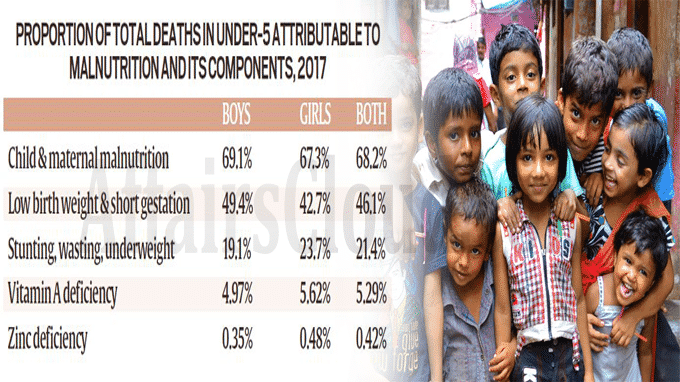 In accordance with the two papers on child survival published by India State-Level Disease Burden Initiative titled “Subnational mapping of under-5 and neonatal mortality trends in India: the Global Burden of Disease Study 2000–17”, child and maternal malnutrition was the predominant risk factorin India as it attributed to 68·2% of under-5 deathswhile low birth weight and short gestation led to 83·0% of neonatal deaths in 2017. On the other hand, 10·8% of under-5 deaths could be attributed to unsafe water and sanitation and 8·8% to air pollution.
In accordance with the two papers on child survival published by India State-Level Disease Burden Initiative titled “Subnational mapping of under-5 and neonatal mortality trends in India: the Global Burden of Disease Study 2000–17”, child and maternal malnutrition was the predominant risk factorin India as it attributed to 68·2% of under-5 deathswhile low birth weight and short gestation led to 83·0% of neonatal deaths in 2017. On the other hand, 10·8% of under-5 deaths could be attributed to unsafe water and sanitation and 8·8% to air pollution.
- The papers are published in Lancet and EClinicial Medicine.
- The Initiative is a collaborative effort among the Indian Council of Medical Research (ICMR), the Public Health Foundation of India (PHFI), the Institute for Health Metrics and Evaluation (IHME), and a number of other key stakeholders in the country.
- The work of this initiative has been approved by the Health Ministry Screening Committee of the Indian Council of Medical Research and the ethics committee of the Public Health Foundation of India.
- These recently published papers are India’s first comprehensive consolidated and detailed analysis of sub-national trends of child mortality and growth failure for all the districts and States in India.
Key Points:
-The studies find that the under-5 mortality rate (U5MR) and neonatal mortality rate (NMR) in the first month of life have dropped substantially since 2000, but there is a 5-6 fold variation in the rates between the States and 8-11 fold variation between the districts.
- U5MR in India decreased from 83·1 in 2000 to 42·4 per 1000 livebirths in 2017.
- NMR decreased from 38·0 to 23·5 per 1000 livebirths.
-Child growth failure, measured as stunting, wasting and underweight has improved in India since 2000, but their rates vary 4-5 fold among the districts and the inequality between the districts within many States has increased.
Highest number of under-five and neonatal deaths in 2017 were reported in Uttar Pradesh (UP) followed by Bihar
In Uttar Pradesh, 48% of the districts fell in the highest priority category of high NMR and low rate of reduction for the nationwide distribution of the district-level rates. The highest number of under-five deaths in 2017 was reported in Uttar Pradesh at 312,800, which included 165,800 neonatal deaths.
- The second highest deaths were reported in Bihar at 141,500 which included 75,300 neonatal deaths.
- In Assam, which the study said, had the second highest child mortality rate in 2017.
Projections:
U5MR: If the U5MR trends estimated up to 2017 were to continue, the projected U5MR for India would be 29·8 per 1000 livebirths in 2025, which would be higher than the NHP 2025 target of 23, and 23·2 in 2030, which would be lower than the SDG 2030 target of 25.
NMR: If the NMR trends up to 2017 were to continue, the projected NMR for India would be 17·6 (14·7–21·4) and 14·7 (11·8–18·4) per 1000 livebirths in 2025 and 2030, respectively.
India’s target of U5MR & NMR
India had the largest proportion, about a fifth, of the 5·4 million under-5 deaths globally in 2017.
- India’s National Health Policy (NHP) 2017 set a target of 23 deaths per 1000 livebirths for under-5 mortality and 16 deaths per 1000 livebirths for neonatal mortality by 2025.
- Government has also set a target of fewer than ten neonatal deaths per 1000 livebirths by 2030 under the India Newborn Action Plan.
- To reach the SDG 2030 targets individually, 246 (34%) districts for U5MR and 430 (59%) districts for NMR would need a higher rate of improvement than they had up to 2017.
Click Here for Official Report
About Global Burden of Disease Study 2000–17:
RakhiDandona, Professor at the Public Health Foundation of India and was the lead author of the child mortality paper.
- Hemalatha, director, National Institute of Nutrition, ICMR, was the lead author of the child growth failure paper.
Funding: Bill & Melinda Gates Foundation; and Indian Council of Medical Research, Department of Health Research, Ministry of Health and Family Welfare, Government of India provided funds for this study.
About PHFI:
President– Prof. K. Srinath Reddy
Headquarter– New Delhi
About IHME:
Director– Dr. Christopher J.L. Murray
Headquarter– Seattle, Washington, United States (US)
About ICMR
Director General– Prof. Balram Bhargava
Headquarter– New Delhi




